
A Google employee in Hamburg (photo taken in mid-2007)
Moma “was designed by and for engineers and for the first couple of years, its home page was devoid of any aesthetic enhancements that didn’t serve to provide information essential to the operation of Google. It was dense and messy and full of numbers that were hard to parse for the uninitiated, but high in nutritional value for the data hungry.
Here’s a picture of the Moma homepage that we got hold of – please note that large areas have been grayed out or whitened out:

On the top of the Google intranet homepage, you’ll find the logo reading “Moma - Inside Google.” Next to it is a search box allowing you to find information from Moma in general, information on specific Google employees, information on availability of meeting rooms, building maps and more. You can choose to include secure content or not via a checkbox. Another checkbox offers you to use “Moma NEXT" for a more experimental variant of search results.
To the top right, there’s an option to switch to iMoma, an iGoogle-style tool prepared by the company which allows further customization of the intranet start page. This way, employees may be able to select their own news and service widgets of interest to be displayed when they log-in.
The actual content of the homepage in the picture is split up into 4 columns. To the left, there’s a “My Office” section, with information for employees and a way to choose your own office for more relevant links. It’s followed by the sections “Survival Kit” and “My shortcuts.” In the middle columns, news gadgets are headlined “Welcome to Google!,” “Communications,” “HR” (human resources), “Company Info” and “Internal Google news,” all in common soft shades of Google base colors. The right column is listing Google teams.
Searching Moma
When you perform a search on Moma, you will see a result similar to the following; this screenshot, which was edited by Google to include comments, has been published by the Google Enterprise Blog in a post of theirs in July to show-case the kind of functionality available:

On the image, you will see a “universal search" style result including employee information, bookmark results, documents hosted on Google’s intranet, and a list of related queries. Users get to choose between ordering by date or by relevance. One can also limit the results to different segments like “Tech,” “Official,” or “Community.” Google in their blog said the use the Google search Appliance to power this service.
Ex-employee Doug Edwards mentioned how he came to take for granted everything was available on the intranet, “from the status of products in development to the number of employees at any point in the company’s history.” He adds that the transparency was also a motivator, as “Your failures are also visible to everyone in the company, which provides an even greater motivator to continuously improve performance in the areas for which you are responsible.” These days however, as Doug writes, Google “clamped down on who had access the complete state of the business.
The following photo shows a result for what seems to be an employee search. The photo is used with permission from Zach at HannaCabana.com, though Zach tells me it had been anonymously submitted to him (note we added blurring to the phone numbers of the zoom version):
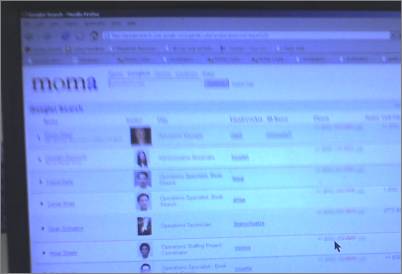
On the employee results page, everyone is listed with their name, a photo, their job title, telephone number and more. Clicking through to an employee lands you on their full profile page. Ex-Googler Doug Edwards remembers how many Google employees used “alternative images and titles" for their Moma listing. “I recall photos of samurai warriors and masked figures with titles like ’Shadow Ops’ and ’Black Ops.’ These were later weeded out as part of an upgrade”.
Employee data may also be rendered in different forms. Below is a screenshot we first posted on in February of an internal application called Google Percent:
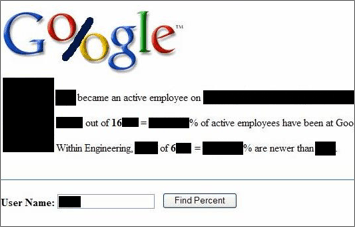
This service simply shows how many employees are newer than a particular other employee (some areas in the image have been blackened out).
How employees access the intranet

Photo courtesy of Zach, again.
The dialog reads, “Many internal apps. One login page.” The input boxes ask for the user’s LDAP (Lightweight Directory Access Protocol) credentials.
A Google employee can log-in to the intranet from within the office, or with a so-called Virtual Private Network (VPN) connection. This connection comes pre-installed on laptops Google hands out, and can be reached via a desktop icon. A Google employee is required to authenticate their sign-in with account credentials.
From within a Google building, an employee may likely reach the intranet via the address corp.google.com. We previously found out Google additionally uses many Sub-Domains in their intranet, like album.corp.google.com, agency.corp.google.com, alien.corp.google.com, karma.corp.google.com, periscope.corp.google.com, pineapple.corp.google.com. You may also likely just enter e.g. “m” (which maps to “http://m” which is “http://m.corp.google.com”) to be taken to a service like your Gmail-powered email account.
Externally, like from a laptop at a conference – or if you’re one of the employees mainly working from home, as there are some – employees can access the VPN servers located on sites like Mountain View or Dublin, Ireland, with different hostnames each like man....ext.google.com or de....ext.google.com (we depleted part of the hostname).
Google “eating their own dog food”
Google employees use many of the tools Google produces. They even have launched an internal “dogfood” campaign in 2006. But what they see may be newer versions of the services than those released to the outside.

Andrew Hitchcock
from July, Creative Commons-licensed(edited for brightness/ contrast).
If you work in a team for a product, you may also get a prototypical version of the service. Below for instance is a screenshot from a nightly build of Google Spreadsheets – codename “Trix” – which we were able to take a look at (note several areas in this image have been grayed out):
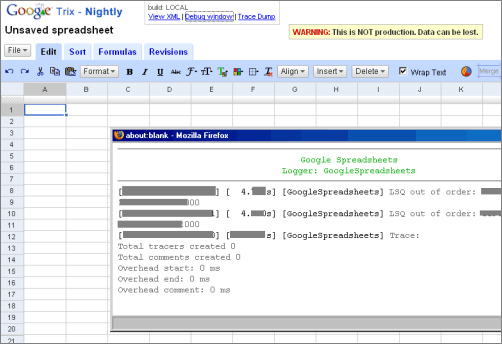
In above image you can see the disclaimer “Warning: This is NOT production. Data can be lost.” Special links to debug windows are offered to developers as well, one of them being opened in the screenshot. Google employees also get to see previews of completely unreleased tools, such as wiki service JotSpot (which is being integrated into Google Apps), or Platypus, the internal Gdrive client for file-sharing.
For code reviews, Google created Mondrian, a “Perforce backend with some custom Google wrappers on top,” as Nial Kennedy, who shot the following photo Creative Commons-licensed, notes:
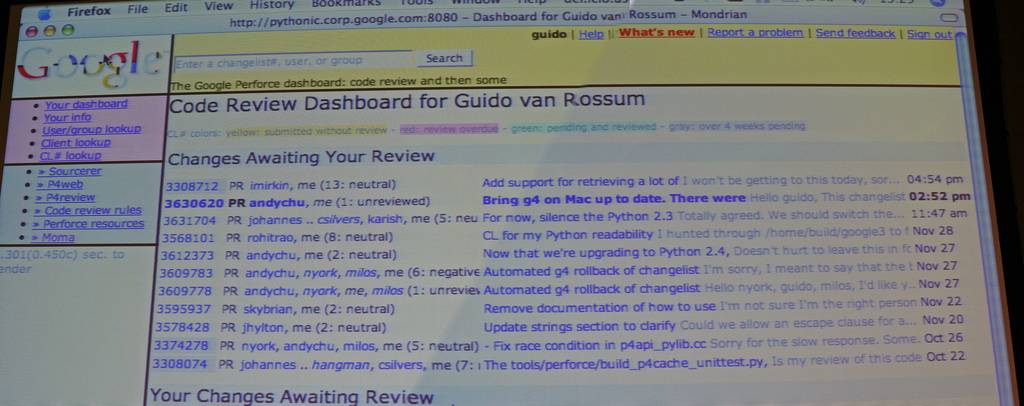
And the following image shows Google in-house tool Trax (this is part of a larger photo by Google employee Andrew from Flickr, but it is not available anymore; we’re not quite sure how this tool works or what it achieves):
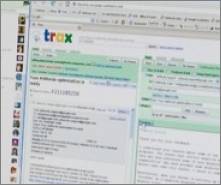
But, Google doesn’t just use their own tools. For instance, we came across information indicating that many Google employees prefer social network Facebook.com to their own production, Orkut (e.g. some Google employees considered Orkut too spammy, or too buggy in the past).
If a Google employee encounters trouble with any Google tool, they can call their internal support hotline named “Tech Stop.” The hotline promises 24-hour availability. Numbers like +1 877... (last part depleted) are partly toll-free and partly with toll, and accessible from all over the world. Internally, a Google employee may also simply press 3-HELP (3-4357). Tech Stop centers aren’t just located in the US, but also in places like Hyderabad, India.
Related Posts: